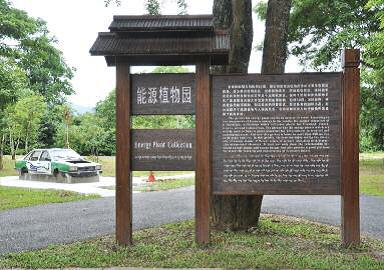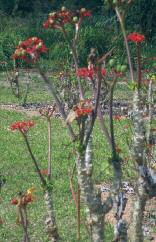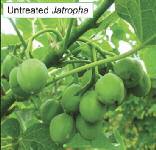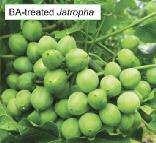
The science exhibition area at XTBG
Botanic gardens are playing important roles in addressing the biofuel issues. In an issue of BG journal, the worldwide journal of botanic garden conservation, bioenergy and the role of botanic gardens are focused. Bionergy plant collection and research in Xishuangbanna Tropical Botanical Garden (XTBG) was reported in Vol 11 (1) January 2014 - Exploring energy gardens: Botanic Gardens and biofuel by Botanic Gardens Conservation International (BGCI).
The Bioenergy Garden in XTBG covers an area of 13 acres. The garden comprises of three areas: the classified collections, the miscellaneous collections, and the popular science exhibition area. It has collections of more than 5,400 energy plants of 350 species belonging to the 50 families. Based on the compounds of biomass in the plants, the Bioenergy Garden is divided into 5 functional collections, including oil, starch, hydrocarbon, fiber, and firewood plants. About 1,490 plants of 141 species belonging to Euphorbiaceae, Myristicaceae, Lauraceae, etc. are grown in the living
collection of oil plants, about 1,410 plants of 57 species belonging to Fagaceae, Araceae, Dioscoreaceae, etc. in the living collection of starch plants, about 400 plants of 12 species of the Euphorbiaceae in the living collection of hydrocarbon plants, about 1,850 plants of 136 species belonging to Urticaceae, Malvaceae, Tiliaceae, etc. in the living collection of fiber plants, and about 250 plants of 4 species belonging to Caesalpiniaceae, Mimosaceae, etc. in the living collection of firewood plants. These bioenergy plants are widely used or have a great potential for biofuel development in tropical and subtropical areas. Examples of these bioenergy plants include: physic nut (Jatropha curcas), which is the most studied bioenergy plant in XTBG, and an oilseed plant used for producing biodiesel and bio-jet fuel; cassava (Manihot esculenta),
a starch plant used for producing bioethanol; African milk bush (Euphorbia tirucalli), a hydrocarbon plant containing a poisonous latex that can be easily converted to the equivalent of gasoline; Miscanthus, the fast-growing perennial grasses with a great potential for production of cellulosic ethanol; and Senna siamea, a tree widely used by the natives of the minority nationality Dai as a firewood.


Energy Plant Colletion Jatropha curcas
Display and exhibition for education
In the popular science exhibition area, visitors can view various displays about bioenergy, such as charts and posters in the bioenergy exhibition hall, sculptures, wall of hopes, wooden car, wooden pistons, and seaweed columns. Thus visitors can see the whole picture of the bioenergy industry, including feedstock supply and logistics, biomass processing and conversion, biorefineries, distribution, bioenergy end use, sustainability, and environmental risks. By visiting this energy garden, visitors can learn about the process from growing bioenergy plants in the field to storing biofuels in fuel tanks, and to can understand the linkages between biological resources and the biofuel industry and connections with global climate change.
This Bioenergy Garden shows the relationship between bioenergy plants and the life of humans, and also provides a good platform for scientific research and exploitation of bioenergy plants. The exhibition of bioenergy plants and the dissemination of new biotechnologies for bioenergy is expected to have an impact on China’s national bioenergy policy and legislation. We believe that tropical areas with abundant rainfall and sunlight are the best place for bioenergy development, and the perennial woody oil plants are the sustainable biofuel feedstock.

Wall of hopes in the Bioenergy Garden
(showing various seeds of bioenergy plants in heart-shaped glass bottles)

Wooden pistons in the Bioenergy Garden
Bioenergy plants research
To take full advantage of these collections of bioenergy plants and promote bioenergy development in China, XTBG has established several research groups devoted to working on such aspects of bioenergy plants as germplasm collection and evaluation, functional genomics, conventional breeding (e.g. hybrid, mutation, polyploid), transgenic breeding, tissue culture propagation, large scale plantation, biofuels conversion, and environmental effects. As an example, we found that treatment with the plant growth regulator 6-benzyladenine (BA, a synthetic compound with cytokinin activity) significantly increased the seed yield of the biofuel plant Jatropha curcas by promoting female flower tendency and increasing the percentage of female flowers and the number of flowers per inflorescence, thus resulting in an increase in fruit number (Journal of Plant Growth Regulation 30 (2): 166-174, 2011).









